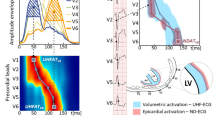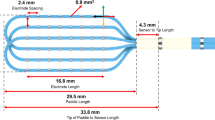Abstract
Atrial tachyarrhythmias often originate from the superior vena cava (SVC), and right superior (RSPV) and inferior pulmonary veins (RIPV). However, a precise differentiation of those origins is challenging using the standard 12-lead electrocardiogram (ECG) P-wave morphology due to the anatomical proximity. The recently developed synthesized 18-lead ECG provides virtual waveforms of the right-sided chest and back leads. This study evaluated the utility of the synthesized 18-lead ECG to differentiate atrial arrhythmias originating from 3 adjacent structures. Synthesized 18-lead ECGs were obtained during SVC-, RSPV-, and RIPV-pacing in 20 patients with lone paroxysmal atrial fibrillation to develop an algorithm. The P-wave morphologies were classified into 4 patterns: positive, negative, biphasic, and isoelectric. Subsequently, the algorithm’s accuracy was validated prospectively in another 40 patients. In retrospective analyses, isoelectric P-waves in synthesized V7 distinguished RIPV-pacing from the others (sensitivity = 81%, specificity = 92%) (first criteria). The P wave morphologies in Leads II (sensitivity = 83%, specificity = 94%) and V1 (sensitivity = 84%, specificity = 80%) distinguished SVC- and RSPV-pacing (second criteria). In a prospective evaluation, the sensitivity, specificity, positive predictive value [PPV], negative predictive value [NPV], and accuracy of the first criteria for identifying RIPV-pacing was 97%, 90%, 78%, 99%, and 92%, respectively. The sensitivity, specificity, RPV, NPV, and accuracy of the second criteria (amplitudes > 1 mV in lead II or biphasic P-waves in lead V1) for discriminating SVC- and RSPV-pacing was 66%, 95%, 98%, 50%, and 74%, respectively. The P wave morphology pattern in lead V7 in synthesized 18-lead ECGs is useful for differentiating RIPV origins from RSPV/SVC origins.




Similar content being viewed by others
References
Haïssaguerre M, Jaïs P, Shah DC, Takahashi A, Hocini M, Quiniou G, Garrigue S, Le Mouroux A, Le Métayer P, Clémenty J (1998) Spontaneous initiation of atrial fibrillation by ectopic beats originating in the pulmonary veins. N Engl J Med 339:659–666
Calkins H, Hindricks G, Cappato R, Kim YH, Saad EB, Aguinaga L, Akar JG, Badhwar V, Brugada J, Camm J, Chen PS, Chen SA, Chung MK, Nielsen JC, Curtis AB, Davies DW, Day JD, d'Avila A, de Groot NMSN, Di Biase L, Duytschaever M, Edgerton JR, Ellenbogen KA, Ellinor PT, Ernst S, Fenelon G, Gerstenfeld EP, Haines DE, Haissaguerre M, Helm RH, Hylek E, Jackman WM, Jalife J, Kalman JM, Kautzner J, Kottkamp H, Kuck KH, Kumagai K, Lee R, Lewalter T, Lindsay BD, Macle L, Mansour M, Marchlinski FE, Michaud GF, Nakagawa H, Natale A, Nattel S, Okumura K, Packer D, Pokushalov E, Reynolds MR, Sanders P, Scanavacca M, Schilling R, Tondo C, Tsao HM, Verma A, Wilber DJ, Yamane T (2017) 2017 HRS/EHRA/ECAS/APHRS/SOLAECE expert consensus statement on catheter and surgical ablation of atrial fibrillation: executive summary. J Arrhythm 33:369–409
Yamane T, Shah DC, Peng JT, Jaïs P, Hocini M, Deisenhofer I, Choi KJ, Macle L, Clémenty J, Haïssaguerre M (2001) Morphological characteristics of P waves during selective pulmonary vein pacing. J Am Coll Cardiol 38:1505–1510
Kuo JY, Tai CT, Tsao HM, Hsieh MH, Tsai CF, Lin WS, Lin YK, Ding YA, Hou CJ, Tsai CH, Chen SA (2003) P wave polarities of an arrhythmogenic focus in patients with paroxysmal atrial fibrillation originating from superior vena cava or right superior pulmonary vein. J Cardiovasc Electrophysiol 14:350–357
Kistler PM, Roberts-Thomson KC, Haqqani HM, Fynn SP, Singarayar S, Vohra JK, Morton JB, Sparks PB, Kalman JM (2006) P-wave morphology in focal atrial tachycardia: development of an algorithm to predict the anatomic site of origin. J Am Coll Cardiol 48:1010–1017
Katoh T, Ueno A, Tanaka K, Suto J, Wei D (2011) Clinical significance of synthesized posterior/right-sided chest lead electrocardiograms in patients with acute chest pain. J Nippon Med Sch 78:22–29
Ashida T, Tani S, Nagao K, Yagi T, Matsumoto N, Hirayama A (2017) Usefulness of synthesized 18-lead electrocardiography in the diagnosis of ST-elevation myocardial infarction: a pilot study. Am J Emerg Med 35:448–457
Nakano M, Ueda M, Ishimura M, Kajiyama T, Hashiguchi N, Kanaeda T, Kondo Y, Hiranuma Y, Kobayashi Y (2014) Estimation of the origin of ventricular outflow tract arrhythmia using synthesized right-sided chest leads. Europace 16:1373–1378
Igarashi M, Nogami A, Sekiguchi Y, Kuroki K, Yamasaki H, Machino T, Yui Y, Ogawa K, Talib AK, Murakoshi N, Kuga K, Aonuma K (2015) The QRS morphology pattern in V5R is a novel and simple parameter for differentiating the origin of idiopathic outflow tract ventricular arrhythmias. Europace 17:1107–1116
Fujimoto Y, Yodogawa K, Takahashi K, Tsuboi I, Hayashi H, Uetake S, Iwasaki YK, Hayashi M, Miyauchi Y, Shimizu W (2017) Noninvasive evaluation of reverse atrial remodeling after catheter ablation of atrial fibrillation by P wave dispersion. Heart Vessels 32:1375–1381
Kimura T, Aizawa Y, Kurata N, Nakajima K, Kashimura S, Kunitomi A, Nishiyama T, Katsumata Y, Nishiyama N, Fukumoto K, Tanimoto Y, Fukuda K, Takatsuki S (2017) Assessment of atrial fibrillation ablation outcomes with clinic ECG, monthly 24-h Holter ECG, and twice-daily telemonitoring ECG. Heart Vessels 32:317–325
Acknowledgements
We thank Mr. John Martin for his help in the preparation of the manuscript.
Funding
None.
Author information
Authors and Affiliations
Corresponding author
Ethics declarations
Conflict of interest
All authors declare that they have no conflict of interest.
Additional information
Publisher's Note
Springer Nature remains neutral with regard to jurisdictional claims in published maps and institutional affiliations.
Rights and permissions
About this article
Cite this article
Hisazaki, K., Miyazaki, S., Hasegawa, K. et al. The P wave morphology in lead V7 on the synthesized 18-lead ECG is a useful parameter for identifying arrhythmias originating from the right inferior pulmonary vein. Heart Vessels 35, 246–251 (2020). https://doi.org/10.1007/s00380-019-01483-1
Received:
Accepted:
Published:
Issue Date:
DOI: https://doi.org/10.1007/s00380-019-01483-1




